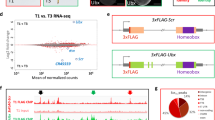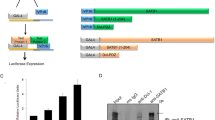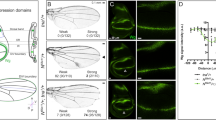Abstract
Wnt signalling controls the transcription of genes that function during normal and malignant development1,2. Stimulation by canonical Wnt ligands activates β-catenin (or Drosophila melanogaster Armadillo) by blocking its phosphorylation, resulting in its stabilization and translocation to the nucleus. Here, Armadillo/β-catenin binds to TCF/LEF transcription factors and recruits chromatin-modifying and -remodelling complexes to transcribe Wnt target genes3,4,5,6. The transcriptional activity of Armadillo/β-catenin depends on two conserved nuclear proteins recently discovered in Drosophila, Pygopus (Pygo) and Legless/BCL-9 (Lgs)7,8,9,10. Lgs functions as an adaptor between Pygo and Armadillo/β-catenin7, but how Armadillo/β-catenin is controlled by Pygo and Lgs is not known. Here, we show that the nuclear localization of Lgs entirely depends on Pygo, which itself is constitutively localized to the nucleus; thus, Pygo functions as a nuclear anchor. Pygo is also required for high nuclear Armadillo levels during Wingless signalling, and together with Lgs increases the transcriptional activity of β-catenin in APC mutant cancer cells. Notably, linking Armadillo to a nuclear localization sequence rescues pygo and lgs mutant fly embryos. This indicates that Pygo and Lgs function in targeting Armadillo/β-catenin to the nucleus, thus ensuring its availability to TCF during Wnt signalling.
This is a preview of subscription content, access via your institution
Access options
Subscribe to this journal
Receive 12 print issues and online access
$209.00 per year
only $17.42 per issue
Buy this article
- Purchase on Springer Link
- Instant access to full article PDF
Prices may be subject to local taxes which are calculated during checkout





Similar content being viewed by others
References
Cadigan, K.M. & Nusse, R. Wnt signaling: a common theme in animal development. Genes Dev. 11, 3286–3305 (1997).
Polakis, P. Wnt signaling and cancer. Genes Dev. 14, 1837–1851 (2000).
Hecht, A., Vleminckx, K., Stemmler, M.P., van Roy, F. & Kemler, R. The p300/CBP acetyltransferases function as transcriptional coactivators of β-catenin in vertebrates. EMBO J. 19, 1839–1850 (2000).
Takemaru, K.I. & Moon, R.T. The transcriptional coactivator CBP interacts with β-catenin to activate gene expression. J. Cell Biol. 149, 249–254 (2000).
Barker, N. et al. The chromatin remodelling factor Brg-1 interacts with β-catenin to promote target gene activation. EMBO J. 20, 4935–4943 (2001).
Bienz, M. & Clevers, H. Armadillo/β-catenin signals in the nucleus — proof beyond a reasonable doubt? Nature Cell Biol. 5, 179–182 (2003).
Kramps, T. et al. Wnt/wingless signaling requires BCL9/Legless-mediated recruitment of Pygopus to the nuclear β-catenin–TCF complex. Cell 109, 47–60 (2002).
Thompson, B., Townsley, F.M., Rosin-Arbesfeld, R., Musisi, H. & Bienz, M. A new nuclear component of the Wnt signalling pathway. Nature Cell Biol. 4, 367–373 (2002).
Parker, D.S., Jemison, J. & Cadigan, K.M. Pygopus, a nuclear PHD-finger protein required for Wingless signaling in Drosophila. Development 129, 2565–2576 (2002).
Belenkaya, T.Y. et al. Pygopus encodes a nuclear protein essential for Wingless/Wnt signaling. Development 129, 4089–4101 (2002).
Townsley, F.M., Thompson, B. & Bienz, M. Pygopus residues required for its binding to Legless are critical for transcription and development. J. Biol. Chem. 279, 5177–5183 (2004).
Thompson, B.J. A Complex of Armadillo, Legless, and Pygopus coactivates dTCF to activate Wingless target genes. Curr. Biol. 14, 458–466 (2004).
Kudo, N. et al. Leptomycin B inhibition of signal-mediated nuclear export by direct binding to CRM1. Exp. Cell Res. 242, 540–547 (1998).
Fagotto, F., Gluck, U. & Gumbiner, B.M. Nuclear localization signal-independent and importin/karyopherin-independent nuclear import of β-catenin. Curr. Biol. 8, 181–190 (1998).
Yokoya, F., Imamoto, N., Tachibana, T. & Yoneda, Y. β-catenin can be transported into the nucleus in a Ran-unassisted manner. Mol. Biol. Cell 10, 1119–1131 (1999).
Wiechens, N. & Fagotto, F. CRM1- and Ran-independent nuclear export of β-catenin. Curr. Biol. 11, 18–27 (2001).
Rosin-Arbesfeld, R., Cliffe, A., Brabletz, T. & Bienz, M. Nuclear export of the APC tumour suppressor controls β-catenin function in transcription. EMBO J. 22, 1101–1113 (2003).
Peifer, M. & Wieschaus, E. The segment polarity gene armadillo encodes a functionally modular protein that is the Drosophila homolog of human plakoglobin. Cell 63, 1167–1176 (1990).
Peifer, M., Sweeton, D., Casey, M. & Wieschaus, E. Wingless signal and Zeste-white 3 kinase trigger opposing changes in the intracellular distribution of Armadillo. Development 120, 369–380 (1994).
Tolwinski, N.S. & Wieschaus, E. Armadillo nuclear import is regulated by cytoplasmic anchor Axin and nuclear anchor dTCF/Pan. Development 128, 2107–2117 (2001).
Zecca, M., Basler, K. & Struhl, G. Direct and long-range action of a Wingless morphogen gradient. Cell 87, 833–844 (1996).
Rowan, A.J. et al. APC mutations in sporadic colorectal tumors: A mutational 'hotspot' and interdependence of the 'two hits'. Proc. Natl Acad. Sci. USA 97, 3352–3357 (2000).
Rosin-Arbesfeld, R., Townsley, F. & Bienz, M. The APC tumour suppressor has a nuclear export function. Nature 406, 1009–1012 (2000).
Zhang, F., White, R.L. & Neufeld, K.L. Cell density and phosphorylation control the subcellular localization of Adenomatous Polyposis Coli protein. Mol. Cell. Biol. 21, 8143–8156 (2001).
Korinek, V. et al. Constitutive transcriptional activation by a β-catenin–Tcf complex in APC−/− colon carcinoma. Science 275, 1784–1787 (1997).
Cox, R.T. et al. Membrane-tethered Drosophila Armadillo cannot transduce Wingless signal on its own. Development 126, 1327–1335 (1999).
Miller, J.R. & Moon, R.T. Analysis of the signaling activities of localization mutants of β-catenin during axis specification in Xenopus. J. Cell Biol. 139, 229–243 (1997).
Pai, L.M., Orsulic, S., Bejsovec, A. & Peifer, M. Negative regulation of Armadillo, a Wingless effector in Drosophila. Development 124, 2255–2266 (1997).
Perrimon, N. The genetic basis of patterned baldness in Drosophila. Cell 76, 781–784 (1994).
Kalderon, D., Roberts, B.L., Richardson, W.D. & Smith, A.E. A short amino acid sequence able to specify nuclear location. Cell 39, 499–509 (1984).
Hamada, F. et al. Negative regulation of Wingless signaling by D-axin, a Drosophila homolog of axin. Science 283, 1739–1742 (1999).
Ahmed, Y., Nouri, A. & Wieschaus, E. Drosophila Apc1 and Apc2 regulate Wingless transduction throughout development. Development 129, 1751–1762 (2002).
Akong, K. et al. Drosophila APC2 and APC1 play overlapping roles in Wingless signaling in the embryo and imaginal discs. Dev. Biol. 250, 91–100 (2002).
Hsu, S.C., Galceran, J. & Grosschedl, R. Modulation of transcriptional regulation by LEF-1 in response to Wnt-1 signaling and association with β-catenin. Mol. Cell. Biol. 18, 4807–4818 (1998).
Gozani, O. et al. The PHD finger of the chromatin-associated protein ING2 functions as a nuclear phosphoinositide receptor. Cell 114, 99–111 (2003).
Huh, W.K. et al. Global analysis of protein localization in budding yeast. Nature 425, 686–691 (2003).
Aasland, R., Gibson, T.J. & Stewart, A.F. The PHD finger: implications for chromatin-mediated transcriptional regulation. Trends Biochem. Sci. 20, 56–59 (1995).
Acknowledgements
We would like to thank K. Basler for Lgs reagents, M. Peifer for the NLS–Armadillo stock, B. Nichols and K. Schmidt for advice with the photobleaching experiments, R. Rosin-Arbesfeld and F. Hamada for plasmids, and B. Thompson, B. Nichols and H. Pelham for discussion and critical comments on the manuscript.
Author information
Authors and Affiliations
Corresponding author
Ethics declarations
Competing interests
The authors declare no competing financial interests.
Supplementary information
Supplementary Figures
Fig. S1, Fig. S2 and Fig. S3 (PDF 379 kb)
Rights and permissions
About this article
Cite this article
Townsley, F., Cliffe, A. & Bienz, M. Pygopus and Legless target Armadillo/β-catenin to the nucleus to enable its transcriptional co-activator function. Nat Cell Biol 6, 626–633 (2004). https://doi.org/10.1038/ncb1141
Received:
Accepted:
Published:
Issue Date:
DOI: https://doi.org/10.1038/ncb1141
This article is cited by
-
Phosphorylated PTTG1 switches its subcellular distribution and promotes β-catenin stabilization and subsequent transcription activity
Oncogene (2023)
-
Novel biphasic mechanism of the canonical Wnt signalling component PYGO2 promotes cardiomyocyte differentiation from hUC-MSCs
Cell and Tissue Research (2023)
-
Genetic alterations shape innate immune cells to foster immunosuppression and cancer immunotherapy resistance
Clinical and Experimental Medicine (2023)
-
ZNF276 promotes the malignant phenotype of breast carcinoma by activating the CYP1B1-mediated Wnt/β-catenin pathway
Cell Death & Disease (2022)
-
Wnt signaling in breast cancer: biological mechanisms, challenges and opportunities
Molecular Cancer (2020)



